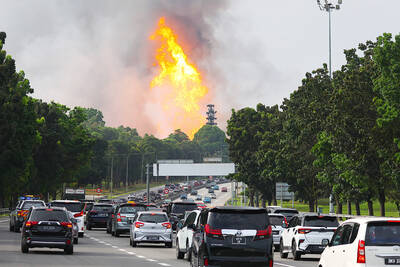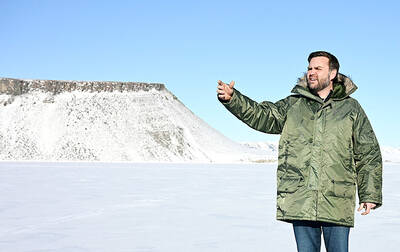China yesterday sent its first-ever satellite built in partnership with another country into space, a device tasked with helping scientists better predict dangerous cyclones and climate change by monitoring ocean surface winds and waves.
A Long March 2C carrier rocket blasted off from the Jiuquan Satellite Launch Center in northwest China’s Gobi Desert at 00:43am GMT, China’s State Administration of Science, Technology and Industry for National Defense said.
The 650kg China-France Oceanography Satellite, the first satellite jointly built by China and France, aims to help climate scientists to better understand interactions between oceans and the atmosphere.

Photo: AFP
It is fitted with two radars: the French-made SWIM spectrometer, which is to measure the direction and the wavelength of waves, and China’s SCAT, a scatterometer that is to analyze the force and direction of winds.
The data collected are to be analyzed in both countries.
The instruments will allow scientists to collect information about winds and waves of the same location simultaneously for the first time, said Wang Lili (王麗麗), chief designer of the satellite at the China Academy of Space Technology, according to Xinhua news agency.

Photo: AFP
“It will help increase the observation and prediction of catastrophic sea states, such as huge waves and tropical storms, and provide security support for offshore operations and engineering, ship navigation, fisheries, and coastal management,” said Zhao Jian (趙堅), a senior official at the China National Space Administration.
The rocket successfully put the satellite into orbit 520km above the Earth.
Chinese President Xi Jinping (習近平) and French President Emmanuel Macron exchanged congratulations in a phone call, according to Xinhua.
“It’s historic. It’s the first satellite China has made through international cooperation,” French National Center for Space Studies president Jean-Yves Le Gall said.
“This satellite will help make considerable progress in understanding climate change,” he said.
The project began in 2007. The two nations are also working together on the Space Variable Objects Monitor (SVOM) mission, which is to launch a satellite in 2021 to detect and study gamma-ray bursts.
China and France already cooperate in space, with a French cardiovascular device aboard China’s Tiangong-2 space lab to monitor a crew’s hearts. The lab is expected to de-orbit after July next year.
Le Gall said France is also working with China on cooperating in exploration missions to the moon and Mars.
China plans to have a crewed space station by 2022 and send a manned mission to the moon in the future.
In related news, a Japanese rocket carrying the United Arab Emirates’ (UAE) first locally made satellite yesterday lifted off from a space center in southern Japan.
The KhalifaSat Earth observation satellite was launched by the Japan Aerospace Exploration Agency from its Tanegashima Space Center.
The H-2A rocket is also carrying an Ibuki-2 greenhouse gas observation satellite for Japan. The launch is part of the UAE’s ambition under its fledging space program.
The nation aims to send its first two astronauts to the International Space Station next year.
The UAE also aims to send a probe on its way to Mars in 2020 and to build a science city there by 2117.
Japan also aims to expand its commercial satellite launch services by Mitsubishi Heavy Industries and make them globally competitive.

A fire caused by a burst gas pipe yesterday spread to several homes and sent a fireball soaring into the sky outside Malaysia’s largest city, injuring more than 100 people. The towering inferno near a gas station in Putra Heights outside Kuala Lumpur was visible for kilometers and lasted for several hours. It happened during a public holiday as Muslims, who are the majority in Malaysia, celebrate the second day of Eid al-Fitr. National oil company Petronas said the fire started at one of its gas pipelines at 8:10am and the affected pipeline was later isolated. Disaster management officials said shutting the

US Vice President J.D. Vance on Friday accused Denmark of not having done enough to protect Greenland, when he visited the strategically placed and resource-rich Danish territory coveted by US President Donald Trump. Vance made his comment during a trip to the Pituffik Space Base in northwestern Greenland, a visit viewed by Copenhagen and Nuuk as a provocation. “Our message to Denmark is very simple: You have not done a good job by the people of Greenland,” Vance told a news conference. “You have under-invested in the people of Greenland, and you have under-invested in the security architecture of this

UNREST: The authorities in Turkey arrested 13 Turkish journalists in five days, deported a BBC correspondent and on Thursday arrested a reporter from Sweden Waving flags and chanting slogans, many hundreds of thousands of anti-government demonstrators on Saturday rallied in Istanbul, Turkey, in defence of democracy after the arrest of Istanbul Mayor Ekrem Imamoglu which sparked Turkey’s worst street unrest in more than a decade. Under a cloudless blue sky, vast crowds gathered in Maltepe on the Asian side of Turkey’s biggest city on the eve of the Eid al-Fitr celebration which started yesterday, marking the end of Ramadan. Ozgur Ozel, chairman of the main opposition Republican People’s Party (CHP), which organized the rally, said there were 2.2 million people in the crowd, but

JOINT EFFORTS: The three countries have been strengthening an alliance and pressing efforts to bolster deterrence against Beijing’s assertiveness in the South China Sea The US, Japan and the Philippines on Friday staged joint naval drills to boost crisis readiness off a disputed South China Sea shoal as a Chinese military ship kept watch from a distance. The Chinese frigate attempted to get closer to the waters, where the warships and aircraft from the three allied countries were undertaking maneuvers off the Scarborough Shoal — also known as Huangyan Island (黃岩島) and claimed by Taiwan and China — in an unsettling moment but it was warned by a Philippine frigate by radio and kept away. “There was a time when they attempted to maneuver